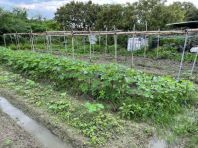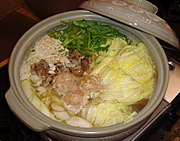Description
Yau Wah Organic Farm
🚚 The Fastest Delivery Time : It takes 1-2 days.
🐝 Supplier / Place Of Origin:Yau Wah Organic Farm / Kam Tin
🔖 Certification: HKORC Certified
🌱 About the Producer:
We need to let everyone know that the fresh organic vegetables are not used with pesticides, and the small insects can coexist. After a child came to the farm, they found that there were vegetable insects on the leaves, so they raised them, and finally found The experience of turning cabbage insects into cabbage butterflies may be a good ecological education. The farmers all have one wish, and hope that the public can support them, understand their hard work, and support them by doing their best to make eating local food a habit: "Hong Kong people support Hong Kong agriculture, buy Hong Kong food!"
🌱 Supplier Products:
🛍 Product Information:
Binomial Name:Brassica rapa subsp. pekinensis
Chinese Name:大白菜
Other Names:Napa Cabbage | Peking Cabbage
Product Description:In Cantonese, my parents always used to refer to napa cabbage as “wong nga bok.”
Sweet, slightly cold in nature. It has the effect of clearing the stomach, digestion, and diuresis. Chinese cabbage is rich in nutrients. Its calcium and phosphorus components can help strengthen teeth and bones, promote and coordinate the operation of the nervous and muscular system; and it contains low calorie value and moderate fiber content, which can provide satiety Besides, eating more will not take in excess energy. In addition, Chinese cabbage contains a variety of plant components, including: sulforaphane (Sulforaphane), indole (Indoles), isothiocyanate (Isothiocyanate), etc., its high antioxidant capacity, help inhibit early cancer cell lesions, Effectively fight and prevent tumor diseases.
Originated in China, it is one of the specialty vegetables in China. The "song" that Ji Han in the Jin Dynasty called in "The Shape of Southern Plants and Trees" is this species. It is cultivated all over the country.
Variety:Dai Bok Choi (大白菜) and Small Chinese cabbage (小白菜), which are often heard when buying vegetables, are both subspecies of the genus Brassica. The difference is not the size, but the presence or absence of "balls". Commonly known Dai Chinese cabbage and Napa cabbage (包心白菜) are both head-bearing cabbage, while all small pak choi are non-head-head cabbage.
Chinese cabbage is made up of multiple leaves tightly wrapped together to form a cylinder. Because the wrapped leaves are not exposed to sunlight, their color is lighter or even light yellow. Generally divided into two types: cylindrical Shaoxing cabbage and short round Baotou Chinese cabbage. The common straight cylindrical vegetable is called "Huangyabai", which is an ecological variant of this species; there is also a cultivated variant with a small plant called "Baby Cabbage".
How many types of cabbage are there?
The cabbage family has its own branches: non-heading cabbage includes ordinary Chinese cabbage, rapeseed, Qingjiang cabbage, Tatsoi, and Chinese cabbage; half-heading cabbage includes oyster cabbage; head-heading cabbage includes Shandong cabbage, Tianjin cabbage, and Napa cabbage. The branches will then extend into various varieties. East Asian countries such as Taiwan, China, Japan, Thailand, and Indonesia all have the habit of eating cabbage, but some terms are different. For example, in China, if you ask a vendor to buy cabbage, you will get a lot of Qingjiang cabbage.
Generally, Chinese cabbage can be further subdivided into Chinese cabbage, cream Chinese cabbage, black-leaf Chinese cabbage, etc. Xie Mingxian explained that different types of non-heading Chinese cabbage have differences in leaf stems, leaf shapes and colors. For example: the leaf color of Chinese cabbage is yellow. Green, butter cabbage and black-leaf cabbage all have white petioles and dark green leaves. Black-leaf cabbage has wrinkled leaves. The larger head cabbage is divided into oval-shaped Shandong cabbage and Tianjin cabbage. Round cabbage.
The English name is Chinese cabbage, which means "Chinese cabbage" and generally refers to a variety of Chinese vegetables. It is named after the shape of cabbage and its leaves curled into a ball.
It's called chou chinois in French and cavolo cinese in Italian, both meaning "big cabbage," just like their English names.
Supply Season:The main production period is from November to February of the next year, and it is available in Hong Kong throughout the year.
Storage Method:Wrap it with toilet paper and put it in a ventilated and dark place, it can be stored for about 1 week; it can also be stored in the refrigerator. The shelf life is shorter in summer, about a few days, and generally about 15 days in winter.
#Should Be / Avoided:
Appropriate: It is suitable for people with difficulty in defecation, internal heat cough, vitamin deficiency, high blood pressure, cardiovascular disease, chickenpox, whooping cough.
Contraindications: People with too cold constitution, weak spleen and stomach, and prone to diarrhea should eat less. In addition, those with intestinal, stomach or heart and lung deficiency should not eat or eat with caution.
Pregnant women can eat Chinese cabbage
Five Flavors in TCM: Bitter, Pungent, Sweet
Efficacy Antipyretic and restorative, clearing the stomach, nourishing the stomach and promoting body fluid, relieving restlessness and quenching thirst, diuresis and laxative, clearing away heat and detoxification
Chinese cabbage is rich in vitamin C and vitamin E. Eating cabbage regularly can enhance the skin's ability to resist damage, and can play a good role in skin care and beauty. Vitamin C in Chinese cabbage also has a certain therapeutic effect on gastric and duodenal ulcers.
The cellulose in Chinese cabbage can not only moisten the intestines, promote detoxification, help digestion, prevent indigestion of pregnant women, prevent pregnant women from suffering from intestinal diseases, and have a good effect on preventing intestinal cancer. Chinese cabbage can also promote the body's absorption of animal protein and prevent senile arteriosclerosis and cardiovascular diseases. In addition, Chinese cabbage also has the effect of preventing breast cancer, and can also prevent arteriosclerosis and cardiovascular diseases.
*Edible Compatibility:
Chinese cabbage with pork can supplement nutrition and laxative. Matching with soy milk can regulate endocrine and anti-aging.
should:
1. Cabbage and tomato: Both Chinese cabbage and tomato are rich in vitamin C and potassium, and eating together can help prevent colds, relax muscles, and relieve emotions.
2. Cabbage and cheese: Both Chinese cabbage and cheese contain calcium and phosphorus and should be paired in moderation. For example, maintaining a high calcium-to-phosphorus ratio helps to form calcium phosphate, which strengthens teeth and bones, and helps prevent osteoporosis and muscle cramps.
3. Cabbage and lean meat: The vitamin C in Chinese cabbage combines with the protein in lean meat, which helps the synthesis of collagen and enhances the elasticity of the skin.
avoid:
1. Cabbage and cucumber: Cucumber contains vitamin C decomposing enzyme components, which will decompose the vitamin C contained in Chinese cabbage, resulting in nutrient loss.
2. Cabbage and pork liver: Pork liver contains copper, which will oxidize the vitamin C contained in oxidized Chinese cabbage, and then reduce the intake of vitamin C.
3. Cabbage, shrimp, squid, etc.: Since these foods are cold in nature, they are likely to cause diarrhea, allergies, asthma, cold hands and feet, etc., so they should be eaten less.
4. Cabbage and licorice: Cabbage is cold in nature and sweet in taste, while licorice is flat in nature and slightly warm in nature. The functions of the two are just opposite. Eating them at the same time can easily cause physical discomfort.
5. Eating Chinese cabbage and Atractylodes atractylodes at the same time will make the medicinal properties of Atractylodes atractylodes overpowering and harmful to the body.
Cooking Skills:We use napa cabbage in soups, stir-fries, slaws, dumplings, noodle dishes, and more. The water content of this vegetable is quite high. When cooked, it has a pleasantly sweet and juicy taste to it.
Notes:If it is marinated with sea salt, pepper and garlic are added to make "kimchi", which is an extremely popular food in Japan, South Korea, and northern China.
Rotten cabbage contains toxins such as nitrite, and these nitrites finally combine with secondary amines in the gastrointestinal tract to synthesize nitrosamine carcinogens. In fact, as long as the human body absorbs a large amount of nitrite, poisoning will occur, and the patient will have degenerative hemoglobinosis, black mouth disease, gastroenteritis, dyspnea, unconsciousness and other symptoms, which are fatal; If left overnight after frying, the nitrite content will also increase sharply, so it is not suitable for consumption, so as not to cause nitrite poisoning.
Dish:
Stir-fried Chinese cabbage with bacon, braised Chinese cabbage with leg paste, and pickled Chinese cabbage.
Cabbage and Tofu Soup
Chinese cabbage in hot pot
Pickle
🔸 Supplementary Information:
Pre -order once a week. The supply depends on the delivery situation, or it will be shipped separately.
Pre -order once a week. The supply depends on the delivery situation, or it will be shipped separately.
🥗 Product Category (English): Napa Cabbage
Google Recipe 🔍 :

English CookPad 🍳 :

BBC Good Food 🥙 :

🔅 Remark:
🍎 Preserve fruits
1. Fruits especially with softer skin, if packaged, should be placed in the cold box in the original package;
2. Organic fruits are more prone to spoilage if they have water droplets. Put the fruits in a ventilated place to dry or wipe off the water vapor, then wrap the fruits in slightly damp newspaper and put them in a plastic bag before refrigerating. ;
3. Organic fruits do not use preservatives or special treatments. fruits are generally stored for three to five days in room temperature only, should be kept in fridge. Some fruits e.g. papaya will decompose enzymes, so they should be eaten as soon as possible.
🍏 How to wash fruits
Special attention: The dishes, especially small flowers and broccoli, are best soaked in the water to remove residual pesticides (this is organic farm, but will have, but not chemical, except to Re-generative Farm). It is recommended to use our vegetables and vegetables environmentally friendly cleaner
Dish Drops for 3 to 5 minutes to eliminate residuals Sand and organic pesticide.
1. Wash fruits before eating to keep them fresh;
2. It is not advisable to soak the fruits for too long, and they should be washed first and then cut to avoid the loss of vitamins;
3. Washing fruits with dilute salt water or Dish Drop can easily remove vegetable insects;
4. Cut fruits with a stainless steel knife to reduce vitamin loss;
5. Vegetable leaves contain a lot of nutrients, so you should avoid shredding, chopping or grinding the leaves;
6. Immediately eat after cutting, to avoid the loss of vitamins due to air oxidation.






















